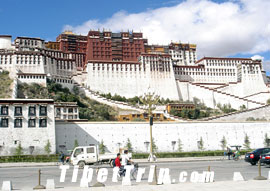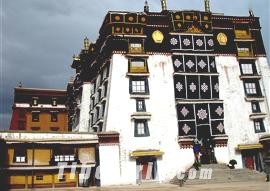 In 631 AD, the great Tibetan King, Songtsen Gampo began to construct the Potala Palace, but it was destroyed by war and lightning in the tenth century. The only remains from the seventh century are the Cave of Dharma King where the Songtsen Gampo practiced Buddhism (Dharma King is the honorary title the people gave to Songtsen Gampo) and a Hall dedicated to Avalokitesvara Bodhisattva. The present buildings were re-constructed by the fifth Dalai Lama in 1645 followed by further re-construction and extension up until 1936 when the stupa chapel for the thirteenth Dalai Lama was finished. The Potala Palace became the chief residence of the Dalai Lama from the middle of the seventeenth century replacing the Drepung Monastery as the center of political power. From then on all major religious and political activities took place there and the stupas of the previous Dalai Lamas were worshipped there as well, with the exception of that of the sixth Dalai Lama.
In 631 AD, the great Tibetan King, Songtsen Gampo began to construct the Potala Palace, but it was destroyed by war and lightning in the tenth century. The only remains from the seventh century are the Cave of Dharma King where the Songtsen Gampo practiced Buddhism (Dharma King is the honorary title the people gave to Songtsen Gampo) and a Hall dedicated to Avalokitesvara Bodhisattva. The present buildings were re-constructed by the fifth Dalai Lama in 1645 followed by further re-construction and extension up until 1936 when the stupa chapel for the thirteenth Dalai Lama was finished. The Potala Palace became the chief residence of the Dalai Lama from the middle of the seventeenth century replacing the Drepung Monastery as the center of political power. From then on all major religious and political activities took place there and the stupas of the previous Dalai Lamas were worshipped there as well, with the exception of that of the sixth Dalai Lama. Potala Palace used to be such a sacred place that it was beyond the reach of the common Tibetans. They could only worship on the square at the foot of the hill. After the fourteenth Dalai Lama fled to India in 1959, the central government turned the Potala Palace into a state museum of historic relics and opened it to the public. Now it is one of the most attractive tourist sites in China and is also a site listed in the World's Cultural and Natural Heritage by UNESCO. Potala Palace is mainly comprised of the Red Palace that occupies the center of the cluster of buildings together with the White Palace that forms the eastern and western sides of the complex. These structures can be easily recognized by the colors of their external walls. The Red Palace is mainly for religious use and it is where Buddhist statues are consecrated. It contains Buddhist halls and stupa chapels of all the former Dalai Lamas other than the sixth holder of the title. The White Palace is the winter palace of Dalai Lama and the main formed of his residence as well as administrative offices. Potala Palace also has some subsidiary buildings that include the Zhacang (the Buddhist College), Buddhist schools and lodging houses, etc.
 During its history of over 1, 300 years, the Potala Palace has become home to an abundance of historical relics. It contains exquisite murals covering an area in excess of 2, 500 square meters (2, 990 square yards), Buddhist pagodas and statues, almost ten thousand thangkas and precious ancient books and records of Buddhist sutras. There are also many relics vouchsafed by the Ming and Qing governments preserved at Potala, such as the Imperial Mandate, the Imperial Golden Seal as well as jade seals, golden and silver articles, porcelain and jade articles and the like.
Potala Palace is not only a masterpiece of Tibetan architecture, but also a treasure-house of the best Tibetan artistic works and precious relics. As such it is a reflection of Tibetan history and culture and an important part of the heritage of mankind in general.
During its history of over 1, 300 years, the Potala Palace has become home to an abundance of historical relics. It contains exquisite murals covering an area in excess of 2, 500 square meters (2, 990 square yards), Buddhist pagodas and statues, almost ten thousand thangkas and precious ancient books and records of Buddhist sutras. There are also many relics vouchsafed by the Ming and Qing governments preserved at Potala, such as the Imperial Mandate, the Imperial Golden Seal as well as jade seals, golden and silver articles, porcelain and jade articles and the like.
Potala Palace is not only a masterpiece of Tibetan architecture, but also a treasure-house of the best Tibetan artistic works and precious relics. As such it is a reflection of Tibetan history and culture and an important part of the heritage of mankind in general.
 Zhol City
Zhol City
Zhol, meaning 'below' in Tibetan, refers specifically to a village or town right below a mountainside castle. Zhol City (Xuecheng), also known as Snow City, is located on the lower boundary of the Potala Palace entrance which is a frontispiece built of its era. Since its grand opening on May 31st, 2007, Zhol City has become a popular hotspot in Lhasa.
Zhol City covers 50,000 sq m. (12 acres) of the Potala Palace complex. It is comprised of 22 ancient buildings which cover an area of 33,470 sq m. (eight acres). These buildings once housed upper and lower class citizens, as well as the city jail and government offices (for the city's administration, judiciary, revenue, and mint). These were established by the three ancient lords of Tibet – the local government, aristocracy, and temple leaders.
Currently 13 attractions are open to the public, including 12 ancient buildings and a tourist service center. Exhibits display artifacts and information, from which one can learn about society in ancient Tibet and the changes it has experienced throughout the years. Visitors can also watch displays demonstrating the process by which local arts, food and drinks are made. Participation is encouraged in some displays, and food samples are typically available. The informational video on Potala Palace and Zhol City, shown at the Tourist Service Center, is another activity that should not be missed. Tour information is available at the Tourist Service Center.
The buildings of Zhol City also include a Treasure Hall, Western Sutra Printing House, and Relics of Granary – all of which are expected to open in 2008. The six remaining buildings (including the city towers) are not expected to be opened to the public due to their limited conditions.
|
Admission Fees
(include Potala Palace and Zhol City) |
CNY 200 (May.1 - Oct.31);
CNY 100 (Nov.1 - Apr.30) |
|
Opening Hours
|
07:30 - 18:40 (May 1 to Oct. 31)
09:00 - 16:40 (Nov. 1 to Apr. 30) 09:00 – 17:00 (ticket reservation time) |
Tips:
1. The Potala Palace only receive 4,000 visitors each day
2. All visitors should finish visiting within 1 hour
3. The tikcet need to be reserved one day in advance








